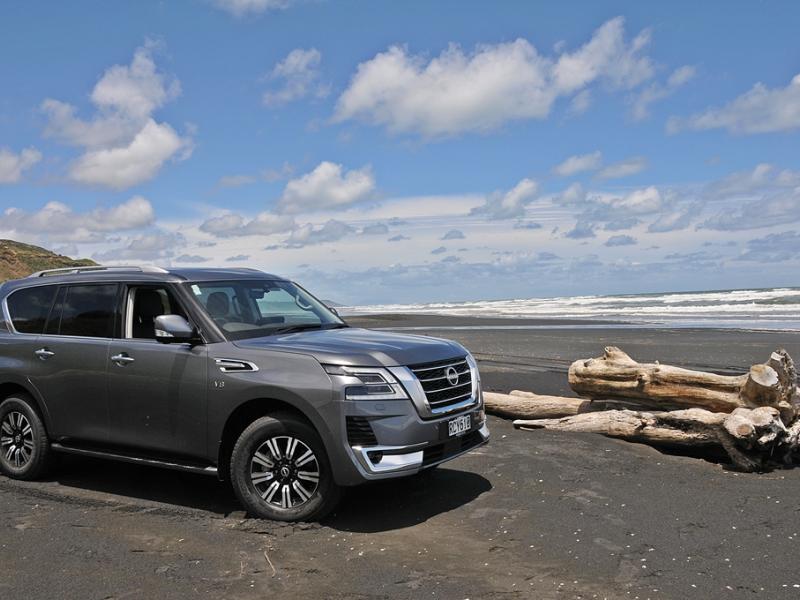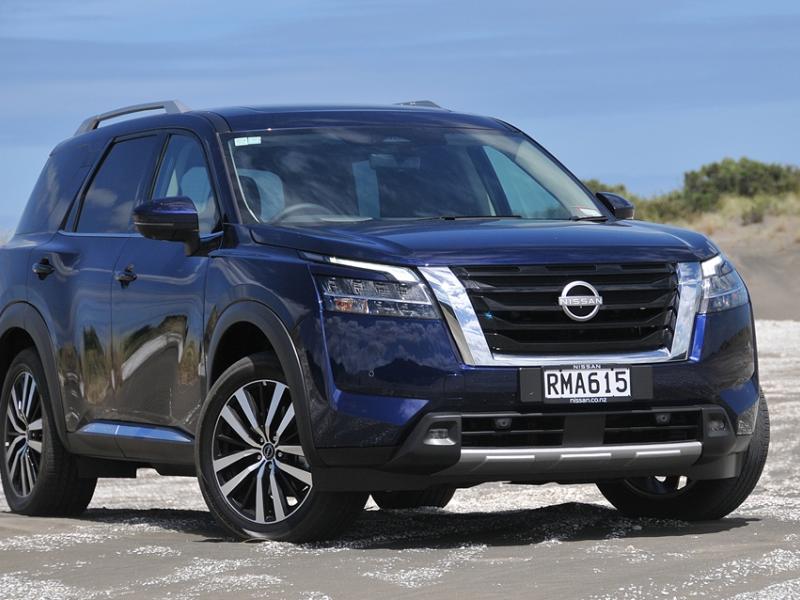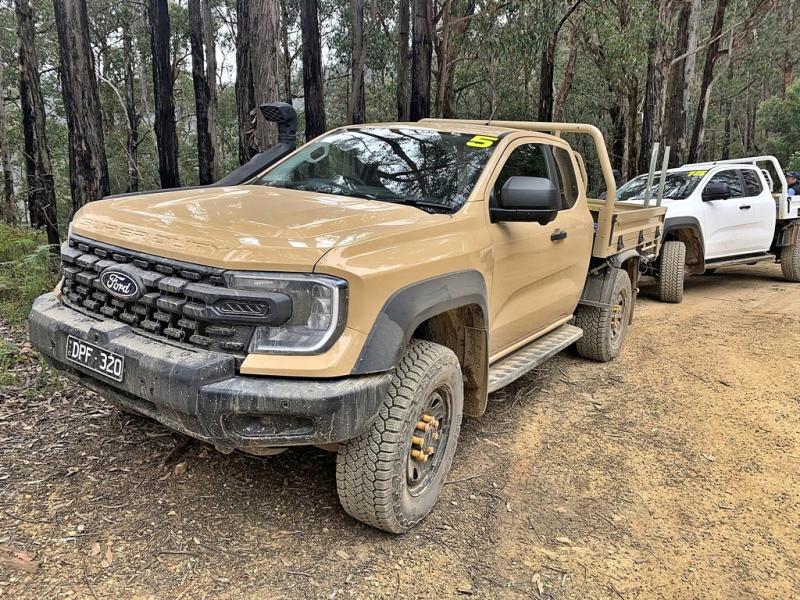Raising the stakes with a long list of ‘firsts’
Jeep’s Grand Cherokee L is a grab-bag of ‘firsts’. It’s all new – the first all-new Grand Cherokee in 11 years, and it’s the first three-row ‘Grand’ ever. We drove it in late June/early July and came away wondering what to leave in/what to leave out of the article.
This thing is slathered in safety and infotainment/communications tech. The superlatives continue: it has the best (simplest, fastest) phone sync of any vehicle we have tested this year; it is the first to feature an embedded McIntosh premium stereo (with quite a few speakers and an enormously powerful amplifier); and as far as can be determined it is the first vehicle to be offered in New Zealand with a night-vision camera built in.
In fact, there are cameras hidden everywhere – under the side mirrors, in the shark-fin antenna, eyeballing the rear seat passengers and out the rear. Many of them have washer nozzles too – handy on cold mornings or after a long run on a muddy road.
The drivetrains are identical: Pentastar V6 petrol engine, eight speed auto and full-time four-wheel drive. Say goodbye to a V8 ‘Grand’, we will not see its like again. Nor is there (currently) a diesel version.
Purists will like the fact that the Summit’s spec is based around QuadraTrac II which delivers an electronically activated low range. The Night Eagle and Limited get QuadraTrac I and do without low range.
Jeep’s QuadraTrac has been around – in various forms – for almost 50 years, gaining greater sophistication and capability along the way.
Also enhancing capability is the company’s Selec-Terrain system, which enables the driver to choose a transmission mode that suits the terrain they are encountering.
The modes are selected by a ‘flipper’ control on the centre console and there are five settings: “Auto”, “Snow”, “Sport”, “Sand/Mud” and “Rock”. This system was first offered in the 2011 Grand Cherokee and is standard on all Jeep Grand Cherokees with a two-speed transfer case.
Finally, the Summit’s air suspension offers driver-selectable ride heights for on-road and off-road, with an extra low setting to ease passenger entry and exit.
While Night Eagle and Limited versions have 20-inch wheels and tyres, the Summit has 21-inch wheels, which appears to be the first use of ‘21s’ on a production vehicle. It has road-oriented 275/55x21 Continental tyres and a full-size (steel wheel) spare.
Summit’s wading depth is a very respectable 610mm. We are not sure many owners will boldly go that deep, but it’s nice to know that we could.
Towing: the Night Eagle and Limited will safely draw along a braked load of 2,813kg; the Summit has a lower 2,270kg rating due to its use of the air suspension. Still plenty for the boat, trailer or caravan.
The Summit we tested gets Jeep’s optional Advanced Technology Group – a very good heads-up display (HUD), wireless charging pocket in the centre console, and most interesting of all, there’s a night vision infra-red camera in the front grille. Anyone who has encountered a cow or sheep sleeping on a rural road at night will know how and why the cam is important. On urban roads, the cam will give early warning of pedestrians or animals close to the road. In both cases the heat ‘signature’ gives what can be life-saving advance notice of a potential hazard. The ATG package is an option at $6,000, but if buyers live rurally or drive a lot at night then it’s certainly worth considering.
The Grand Cherokee range starts with the Night Eagle, which sneaks in under $100,000 at $99,990; steps up to the Limited at $104,990 and tops out with the Summit we drove, which offers 5.2 metres of premium four wheeling for $134,990. All those prices exclude the usual exclusions and the Government’s ‘ute tax’.
Across the range, as with the outgoing version, the ‘hero’ exterior colour of the nine available is the bright white scheme on our test vehicle, which is set off by a gloss black roof that deceptively hides a full-sized sunroof. We believe many will opt for this colour - or go for the diamond black, which creates a distinct on-road presence when applied on a vehicle this size and creates an almost monolithic look from either side thanks to the (quite dark) tints of the cabin’s acoustic glass.
On the topic of acoustics, the Summit has a premium McIntosh sound system with 19 speakers. Not many new luxury vehicles can come close. Most have a few more speakers than cupholders – or USB outlets. But 19 speakers? Strewth. And a 760-Watt amplifier? Keep the teenager away from that thing.
There’s even a cool main-screen option that recreates the old ‘VU’ meters from the age of analogue. Pleasing to the Boomer’s eye.
There are 12-way power memory seats with heating and lower back lumbar massage function for both front passengers, and for those who need it, know that this is a ‘proper’ seven-seater. The legroom – especially in the second row – is immense.
Then when passengers are not in the mix but big loads are, simply fold down rows two and three and the stowage area becomes a space of almost 1400 litres.
But back to those front seats for a moment. That massage/heat function deserves further comment: on a cold blustery day, having been out doing something suitably outdoorsy like cutting a load of firewood, it is blissful to tuck back into the ‘Grand’ and add warmth (three levels are available) to a very sophisticated lower back kneading. Frozen extremities? Turn on the heated steering wheel as well.
The aircon is a four-zone independent climate control meaning the second-row passengers have their own microclimate to enjoy.
In the dash there’s a 10.1” Uconnect 5 display with Apple CarPlay and Android Auto, and a 10.25” multi-view display cluster.
With its sculpted interior panels, open-grain ash timber trim sections and accent-stitched leather this is a very pleasant place to be while motoring.
The 3604cc Pentastar engine delivers the six-cylinder refinement expected, cruising unobtrusively along at very low revs on the open road but providing a stirring snarly V6 soundtrack under acceleration. It produces 210kW at 6,350rpm with peak torque of 344Nm arriving at 4,300rpm. The engine is tied closely with the subframe for the front diff, enabling a lower mounting for improved handling.
Couple it with an eight-speed automatic transmission with well chosen ratios and there’s almost no reason to use the paddle shifters. Likewise, there is a Sport mode, but little need to use it from day to day. It’s just cool to know it is there, and handy to select from time to time.
For those who really don’t need seven seats there’s a standard-wheelbase five-seat version on the way in early 2023. Similarly, a plug-in hybrid electric vehicle (PHEV) version arrives next year with a 2.0-litre turbo-petrol engine, making a combined 280kW and offering an electric-only range of 40km.
A Grand day out
It’s always good to test these vehicles on roads owners would happily tackle, on missions they might like to undertake. For a bit of a change, we headed south-east to the Firth of Thames, through some very tight and twisty ‘B’-roads that enabled us to stay away from the motorway.
We first dropped south then up past an old stomping ground from the dim dark past when rallying was huge. Pinnacle Hill Road, Koheroa Road, down around Maramarua Forest and then back up and out toward the Red Fox tavern and east to the coast. This is – or was – all farm country and rally roads.
No mistake, this is a big piece of kit on narrow rural roads slimed with moss in mid-winter. The multiple single lane bridges in that area required a bit of attention, especially when a local coming the other way ignores those terribly small ‘Give Way’ signs. Perhaps they assume the townie coming the other way will get the sweats at the thought of plowing a $134,000 SUV into their tractor or rumpty farm ute. Perhaps they are quite right.
No ABS braking was required at any time during these ‘moments’, and it wasn’t long before we popped out at Miranda and onto the coast road. This whole area was once an enormous salt marsh and the efforts of a couple of generations of farmers and councils have only partially succeeded in turning it into viable pasture. Many small streams drain the tide back out of the fields.
The area, of course, is known as the seabird coast. A couple of decades ago, we hosted the editor of the ‘real’ Top Gear magazine, Kevin Blick, on a multi-day drive experience down through here to the Coromandel and on to Rotorua. He was accompanied by award-winning photographer Michael Baillie and they came at the invitation of Tourism New Zealand, delivering in return an inspiring 12-page feature in the mag.
Over world-class fish and chips at Kaiaua, our travelogue narrative (in our best David Attenborough voices) went “and now we motor south past the world-famous Seabird Coast, home to millions and millions of… well… seabirds.” Giggle. Certainly, the gulls and oystercatchers were there in serious numbers, as were the fully-fledged birdwatcher types, hung with binoculars and thermos flasks.
A short cruise along the road and there are multiple turning points that give access to waterside tracks and a large freedom camping area for motor homes and caravans.
Choosing one, we turn along a shell-and-sand track to a decent photo point where we are distracted by a bloke and his son dragging sea kayaks up off the mudflats to their workhorse Colorado. A two-bloke limit in snapper and a single gurnard were the reward for their slog. Identities must remain anonymous, as must ‘spot X’. It’s the Code of the Fisherman. Any location that hands over that many ‘snaps’ in not much more than a half hour of fishing in a metre of water is worth protecting.
Here we tried out the air suspension’s multiple settings, though not from any need to do so, simply to see how they worked. It would be well worth Jeep’s time to set up some practical sessions to show new owners just how good this kind of technology is.
Motoring off, we took a quick (slow) motor through the freedom camping area, home to dozens and dozens of caravans and enormous motor homes, with devoted birdy types fluttering around stowing away the day’s safari chairs and e-bikes and readying for their gin sundowners.
Cyclists take note: there are well formed trails from the freedom camp all the way to Kaiaua – and maybe further. This bears further investigation when the weather warms up a little.
Heading north again, the air suspension’s adjustability comes into its own on the rutted vehicle tracks here, and for future reference the best setting for such surfaces is number three, one up from regular road height. Higher settings are not necessary and tend to accentuate pitch and roll; lower would occasionally cause mudflaps to scrape the ground.
From Kaiaua, we reluctantly return to Auckland through Mangatangi reach the Bombay hills, submitting to the boredom of motorway driving.
Verdict: this new ‘Grand’ is a worthy replacement for its predecessor, the tech and spec really cries out for dealership forecourt briefings for buyers, and there is no reason to bewail the absence of the V8. It is every bit a credible rival for the many other seven-seaters out there.






